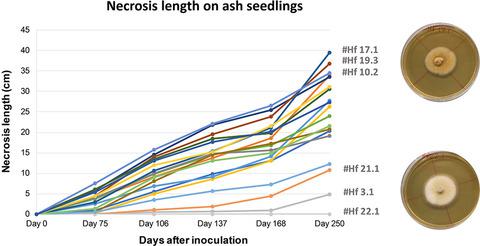当前位置:
X-MOL 学术
›
Plant Pathol.
›
论文详情
Our official English website, www.x-mol.net, welcomes your feedback! (Note: you will need to create a separate account there.)
Variation in aggressiveness of Hymenoscyphus fraxineus genotypes amid the Ash dieback epidemic
Plant Pathology ( IF 2.7 ) Pub Date : 2020-05-01 , DOI: 10.1111/ppa.13158 Chatchai Kosawang 1 , Lea V. McKinney 1 , Lene R. Nielsen 1 , Erik D. Kjær 1
Plant Pathology ( IF 2.7 ) Pub Date : 2020-05-01 , DOI: 10.1111/ppa.13158 Chatchai Kosawang 1 , Lea V. McKinney 1 , Lene R. Nielsen 1 , Erik D. Kjær 1
Affiliation

|
The ascomycete Hymenoscyphus fraxineus causes devastating damage to the European common ash (Fraxinus excelsior). The fungus originates from Asia, where it coexists with native ash species and completes its life cycle by sporulating on degrading ash leaf litter on the forest floor. Given this life cycle of the fungus, genotypes of H. fraxineus with varying degrees of aggressiveness may coexist in infected European ash forests. To test this hypothesis, we cultured 19 single‐spore isolates from apothecia collected in a trial of heavily infected ash in Denmark and carried out stem inoculations on young ash seedlings. Microsatellite markers revealed that the 19 isolates were all genetically unique and did not show any genetic structure. High variation was observed among the 19 isolates in pathogenicity on young seedlings. The variation (assessed as necrosis development) was highly significant, but not correlated with the vigour of the fungal isolates when grown on culture media. The results support the hypothesis that aggressiveness of H. fraxineus may not be crucial for its fitness. In this sense, ash dieback disease may differ from other recent emerging infectious diseases on trees. We discuss the variation in aggressiveness of H. fraxineus in relation to durability of resistance and future management of the ash dieback epidemic. The findings of this study call for more research into natural variation in endophytic versus pathogenic behaviour of H. fraxineus on European ash.
更新日期:2020-05-01

























 京公网安备 11010802027423号
京公网安备 11010802027423号